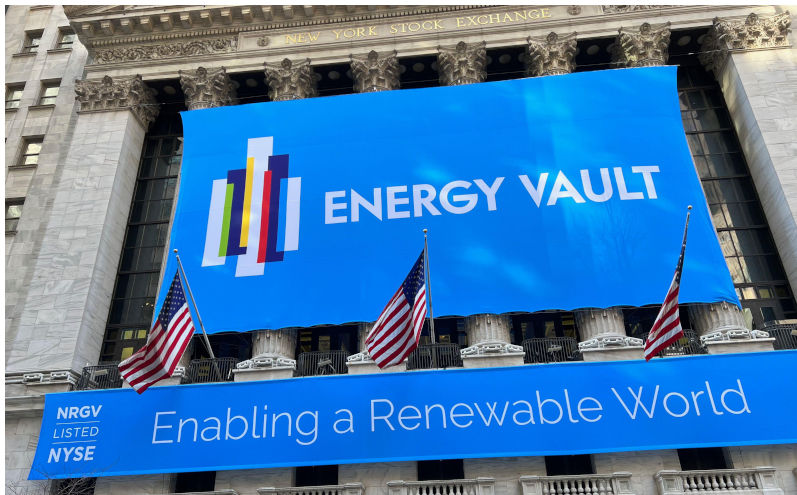Giant eight-hour battery project changes hands as storage costs plunge 40%
March 22, 2025
A giant eight-hour battery project in New South Wales has changed hands in a deal that also confirms that battery storage costs — a critical part of the green energy transition — are still falling significantly.
The California-based Energy Vault announced on 18 March that it had agreed to buy the 125 MW, 1000 MWh Stoney Creek battery project near Narrabri from Australian developer Enervest.
Stoney Creek just last month was named as one of three projects that landed a 14-year underwriting agreement from the NSW Government through its latest long duration storage tender. It is one of five eight-hour batteries that are being built in NSW to support the state’s transition away from coal-fired generation.
Energy Vault, which initially made its mark with a new design for “gravity storage”, is rapidly emerging as a major player in the conventional lithium ion battery sector, and has a rapidly expanding portfolio in Australia.
It had already been chosen as the technology supplier for the Stoney Creek project, and the announcement reveals that the cost of the project will be US$220 million (A$350 million), underlining the continued and rapid fall in battery storage costs being enjoyed by the sector.
Energy Vault puts the cost decline in battery storage at around 40% over the past year. “We’ve seen a tremendous price erosion and degradation in the pricing associated with lithium ion and LFP technologies,” chairman and chief executive Robert Picconi told analysts on a conference call overnight.
That fall in battery costs was last week cited by mining giant Rio Tinto as it signed up to a massive solar and battery project in Queensland that will play a key role in transitioning its giant smelters and refineries from coal to renewables and storage by the end of the decade.
The deal with Enervest is part of Energy Vault’s strategy of being an “owner and operator” of battery storage projects. It will provide its energy management systems and manage the project over the long term, while Enervest will continue to provide the project development services and stakeholder engagement.
Picconi gave rare insight into the details of the Long Term Energy Saving Agreement (LTESA)contracts, telling the analysts briefing that the LTESA signed with the NSW Government guarantees a minimum of US$20 million revenue a year.
“We’re allowed to participate in the market under merchant revenue through the life of the contract, but the $20,000,000 is a guaranteed minimum with other characteristics and things through the life of the contractor, the 14 years,” he said.
“If we have merchant revenue above the US$20 million we’re allowed to take 100% of that revenue up to US$36 million. Above US$36 million there is a sharing essentially with the government of fifty-fifty on that revenue. So those are annual numbers of the contract.”
Picconi says the company expects a healthy margin for the project.
He also noted that Australia battery projects should be largely shielded from tariffs that could affect the cost of projects in the US.
“We’re taking advantage of the fact that the pricing … out of China has come down broadly, again. I think also even the providers are targeting Australia … as a market to try to achieve a little better than what they’re achieving potentially in the US."
Energy Vault’s portfolio of projects in Australia now totals 2.6 GWh of storage, including recent agreements with Acen Australia (where it is building the 200 MW, 400 MWh New England battery) and the Victorian Government-owned State Electricity Commission for a 100 MW, 200 MWh battery at Horsham.
It has previously announced another 1000 MWh contract for the early stage Meadow Creek battery in Victoria.
The company’s annual results released overnight (17 March, US time), reveal just US$46 million in annual revenues and a full year loss of US$135 million, but it expects revenue to jump sharply this coming year to around US$300 million, thanks to a growing pipeline of US$2.1 billion and 9.4 GWh of projects, with Australia a major component.
Energy Vault said the revenue was 7% below the low end of its own guidance range, and put that down to declining battery prices and the timing of “revenue recognition associated with battery projects in Australia and gravity license revenue".
However, it is yet to convince the market, with Energy Vault’s share price closing on 17 March at US$1.14, down from a 2025 high of US$2.53.
Ross Warby, the chief executive of Enervest, which also has a large portfolio of battery storage projects in development, said in a statement: “Energy Vault’s partnership has been highly valuable in securing the LTESA for this project, and we look forward to continued collaboration as part of our mission to advance Australia’s energy future.”
See Renew Economy’s Big Battery Storage Map of Australia for more information.
If you look at the last three years, it’s amazing to me the amount of change we’ve seen, just between things like the lithium ion pricing and how that’s evolved, how markets have evolved with data centres and AI and what’s that striving in terms of power demand, and just fundamentally, generally, the need for more and more cost effective, sustainable and safe energy storage.
Republished from RENEW ECONOMY, March 18, 2025
